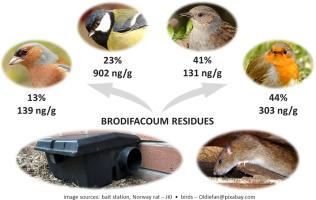Science of the Total Environment ( IF 8.2 ) Pub Date : 2020-12-17 , DOI: 10.1016/j.scitotenv.2020.144160
Bernd Walther , Anke Geduhn , Detlef Schenke , Jens Jacob

|
The exposure of non-target wildlife to anticoagulant compounds used for rodent control is a well-known phenomenon. Exposure can be primary when non-target species consume bait or secondary via uptake of poisoned animals by mammalian and avian predators. However, nothing is known about the exposure patterns in passerine birds that are commonly present on farms where rodent control is conducted.
We used liquid chromatography coupled with tandem mass spectrometry to screen for residues of anticoagulant rodenticides (ARs) in liver tissue of passerine birds that were present during rodent control with a product containing brodifacoum (BR). The 222 birds of 13 species were bycatch of rodent snap trapping in 2011-2013 on 11 livestock farms run synchronously with baiting.
During baiting, ARs were detected in about 30% of birds; 28% carried BR. In liver tissue of 54 birds that carried BR, concentrations ranged from 4-7,809 ng/g (mean 490 ±169 ng/g). Among common bird species with AR residues, BR was most prevalent in robins (Erithacus rubecula) (44%) and dunnocks (Prunella modularis) (41%). Mean BR concentration was highest in great tits (Parus major) (902 ±405 ng/g). The occurrence and concentrations of BR residues were about 30% higher in birds collected close to bait stations compared to birds collected further away.
The results demonstrate that several ground feeding songbird species are exposed to ARs used on farms. If BR was present in liver tissue, concentrations were variable, which may imply a combination of primary and secondary exposure of songbirds. Exposure was mostly restricted to the immediate surroundings of farms where bait was used, which might limit the transfer to the wider environment. Efforts should be made to reduce the access for birds to AR bait to prevent high exposure.
中文翻译:

饲养挪威鼠的过程中,雀形目鸟类接触溴地鼠
非目标野生生物接触用于啮齿动物控制的抗凝化合物是众所周知的现象。当非目标物种食用诱饵时,接触可能是主要的,而哺乳动物和禽类捕食者对中毒动物的吸收则可能是次要的。但是,对于进行啮齿动物控制的农场中常见的雀形目鸟类的接触方式一无所知。
我们使用液相色谱与串联质谱联用,以筛选在含有含溴地古丁(BR)的啮齿动物控制期间存在的雀形目鸟类肝脏组织中抗凝血灭鼠剂(ARs)的残留物。2011-2013年,在11个与诱饵同步运行的牧场上,共捕获了13种动物的222只鸟类的啮齿类动物捕捉诱捕。
在诱饵过程中,大约30%的鸟类检测到AR。28%携带BR。在54只携带BR的鸟类的肝脏组织中,浓度范围为4-7,809 ng / g(平均490±169 ng / g)。在具有AR残留的常见鸟类中,BR最常见于知更鸟(Erithacus rubecula)(44%)和沙丘(Prunella moduleis )(41%)。平均数BR浓度最高的是大山雀(大山雀)(902±405纳克/克)。与远离诱饵站收集的鸟相比,在诱饵站附近收集的鸟中BR残留物的发生和浓度高约30%。
结果表明,几种地面喂养的鸣禽物种暴露于农场使用的AR。如果肝组织中存在BR,则其浓度是可变的,这可能意味着鸣禽的初次和二次接触相结合。接触大多限于使用诱饵的农场附近地区,这可能会限制向更广泛环境的转移。应努力减少禽类获得AR诱饵的机会,以防止高暴露。







































 京公网安备 11010802027423号
京公网安备 11010802027423号